FRENCH CORPS ORGANIZATION (REPRESENTATIVE) CIRCA 1859
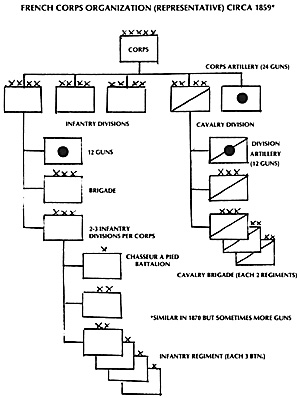
PIEDMONTESE DIVISION ORGANIZATION 1859
(No Corps Organization)
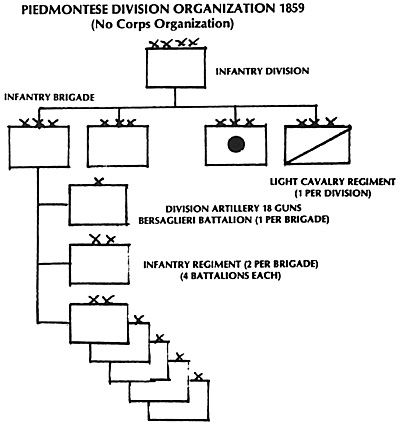
Sardinian Army ORGANIZATION 1859
The Sardinian Army at the time of the Crimean War was organized much as it was in the War of Liberation in 1859. However, the expeditionary force sent to the Crimea was composed of drafts of a company from each battalion of infantry, and two companies from each battalion of Bersaglieri. This provided ten provisional regiments of two battalions each and five unattached Bersaglieri battalions. Artillery support is unknown but probably on the order of twenty-four pieces in two to three batteries. The infantry was formed in two divisions of four provisional regiments each and a reserve brigade of two provisional regiments.
The line infantry carried a percussion musket at this time, except that about twenty percent or less were issued a short heavy cap and ball rifle of the same pattern as that issued to the Bersaglieri. From the description it sounds very like the sharpshooter's model carried by the carabinier (elite) companies of French chasseur a pied battalions prior to the introduction of the 1853 Minie rifle. it was decidedly superior to the Napoleonic rif le corps weapons, especially to the Brunswick rifle used by the Russian lager. But it was just as inferior to the Minie rifle carried in the Crimean War by most British troops and by the French sharpshooters (chasseurs a pied).
Sardinian cavalry was as in the 1859 war - four heavy regiments with saber, lance, pistols, and (at least later on) carbine, two lancer regiments armed with saber, lance and "pistillon", a rifled short carbine with a 12" barrel that could be fired as either a pistol or a carbine, and three regiments of light horse armed with saber, horse pistol, and a rifle with a 30" barrel. In the Crimea this force was represented by a provisional regiment of four squadrons of 130 men each, two of lancers and two of light horse. Players may wish to increase this to a base of each to lend tone to the brawl.
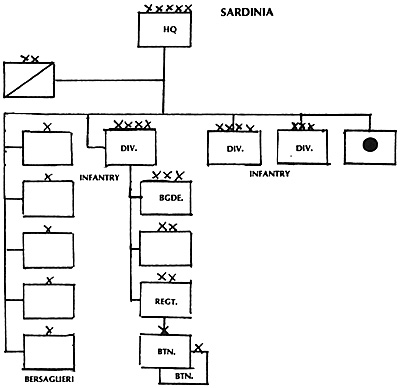
AUSTRIAN CORPS ORGANIZATION CIRCA 1859
A cavalry division of 4 strong regiments of light horse and 16 horse guns was attached to each of two field armies as well as 88 guns of reserve artillery.
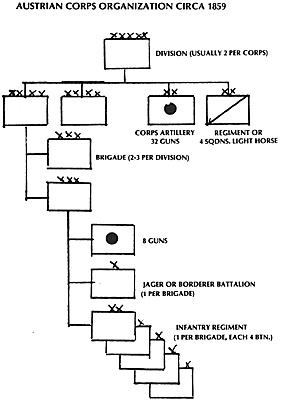
AUSTRIAN CORPS ORGANIZATION 1866
There were 2 light and 3 heavy reserve cavalry divisions. The light units had 3 brigades of 2 regiments each. The heavy divisions had 2 brigades each of 2 cuirassier and 1 uhlan regiments. Each brigade of horse was supported by a horse battery of eight 4 pdr guns. Although in 1859 the Austrian artillery was smoothbore, the performance of the smaller number of French rifled cannon so impressed the Austrians that they converted entirely to rifles (except for one rocket battery per regiment) by 1866.
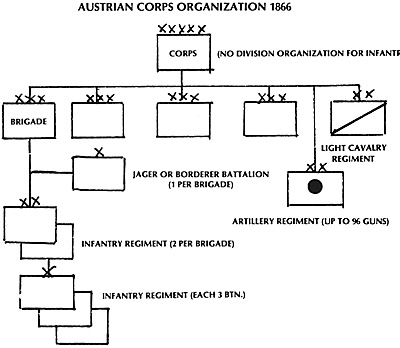
THE BRITISH ARMY IN THE CRIMEAN WAR (1854-56)
The British Army in the Crimean War was organized remarkably as it had been in the Napoleonic Wars - or, for that matter, as it would be as late as WWII with various minor adjustments. The battalion was the basic tactical unit, and formed part of a "brigade" normally of three battalions from different nominal "regiments". Regiments normally had a first battalion on active duty and a second in reserve. Two or more batteries might be attached to a division, and two or more divisions designated a corps. The attachment of cavalry regiments to divisions or brigades to corps sometimes appeared as standard in The Queen's Regulations but was not universal - and, of course, was not followed in the Crimea, where a separate division of two (one each light and heavy) brigades was formed.
British cavalry usually had only three squadrons per regiment as compared to from six to ten for Russian, and from four to six for other nations' cavalry. This cavalry was, however, superbly drilled and mounted. G.B. McClellan, a U.S. Army observer in the Crimea, noted that British cavalry was all mounted on superb heavy cavalry horses--in fact, that for practical purposes, it was all heavy cavalry. The excellent ability to execute formed charges and negligible ability to conduct reconnaissance on the part of the Light Brigade confirms that impression. While in pure numbers it would take the entire Light Brigade of four regiments to justify a single cavalry base in this game, its unusual fighting spirit may justify representation with two to four. This cavalry should be given medium to heavy combat power with light cavalry speed. However, like the Russian cavalry (except for Cossacks) it used no more than token foragers.
In the early stages of the Crimean War, British infantry used the 1853 Minie rifle except for the 2nd Division, which used percussion muskets.
For game purposes, the British battalion, which fought in double line like the light troops of France and Germany, should have bases 2.25" wide. This, together with abnormal musketry training, could justify a +1 on "one shot" musketry tables and +2 on summary fire tables. Rifle battalions would go up to +2 and +3 respectively. Also, the British battalions actually maneuvered in line where most armies would use field or battle columns. Therefore, instead of a "tactical maneuver" move, British units are allowed an additional 1" per turn in line.
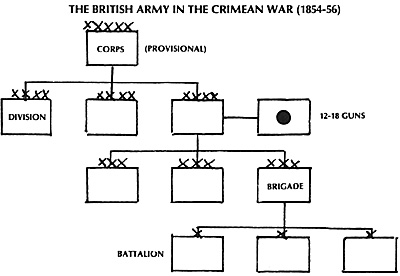
PRUSSIAN CORPS ORGANIZATION
The larger Prussian cavalry organizations differed in 1866 and 1870. In 1866 some divisions were formed with whole brigades or the total division light or heavy. Cuirassiers were classed as heavy, lancers (uhlans) as medium, dragoons and hussars, light. In 1870 brigades and divisions were mixed, and an effort was made to ensure that heavy and medium horse had light cavalry along for dismounted duty (cuirassiers and uhlans had no carbines). Attached artillery varied.
In 1866 the Prussian 11 Corps had attached the so-called 3rd Heavy Brigade or the 2nd Cuirassier sand the 9th Uhlans in addition to the 5th Hussars of the 3rd Infantry Division and the 4th Uhlans of the 4th Infantry Division. Most corps only had the two divisional regiments. Large cavalry masses were held at I Army in the form of the Cavalry Corps of 1 Cavalry Division with a heavy brigade of the6th and 7th Cuirassiers, a light brigade of 1 and 2 Guard Uhlan, 1 Guard Dragoon. The 2 Cavalry Division had two light brigades resepctively, the 2nd 12 Guard Dragoon, 3 Hussar, 11 Hussar, 3 Light Brigade, 3 Dragoons, 12 Hussars. In 1870 all the Guard Dragoons, Uhlans, Cuirassiers, and Hussars were formed into the Guard Cavalry Division appropriately attached to the Guard Corps.
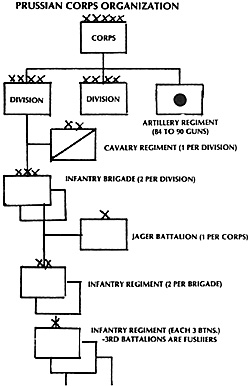
THE RUSSIAN ARMY IN THE CRIMEAN WAR
The Russian Army of the Crimean period was sometimes admired for its size and structure. On the whole, however, it was deficient in firepower and mobility for its infantry, and its regular cavalry, while extremely numerous, was not trained for either initiative or shock. The artillery, on the other hand, was numerous and powerful. In practice each infantry division was supported by a brigade of 24 field guns, 8 heavy and 16 light. The cavalry division, with normally 6 very strong squadrons in each regiment, was supported by 16 horse guns. In this period the infantry and dragoons (10 squadrons, 2 with lances) were equipped with smoothbore muskets, the artillery all smoothbore. In each corps a single battalion of jager carried rifles - but these were Brunswick rifles which pre-dated Captain Minie's innovations - an inferior percussion version of the Napoleonic rifle corps weapon.
The cavalry was trained to charge only for 150 yards compared to 250 to 500 or more for the cavalry of other nations. Except for the Cossacks only token skirmishers (foragers) were used. In this game Russian cavalry at full strength should be represented with two bases, dragoons (10 squadrons) with three, one of which should be lancers. Impetus, or shock value is only 1 point per base except for the dragoon lancers, who may be given half a point more. No tactical maneuver move is allowed and the charge move is equal to the normal tactical maneuver rate of other horse. Cossacks are free to use tactical maneuver and normal charge moves for light horse, but have only. melee value and I point of shock value. They are also given a -1 on morale rolls, but suffer no morale disadvantage from fighting in open order.
Russian infantry does not benefit from tactical maneuver or charge moves, since its charge seems to have been at a slow rate.
The Russian Army was very thoroughly organized. It contained 6 infantry corps, a guard infantry corps, and a grenadier corps, a guard reserve cavalry corps, 2 reserve cavalry corps and a reserve light cavalry corps was well as the Army of the Caucasus and numerous Cossack formations. The 5th Infantry Corps, as an example, followed the structure shown above. It included the 5th Light Cavalry Division, with the 5th Lancer Brigade of the 9th and loth Lancer Regiments, the 5th Hussar Brigade of the 9th and loth Hussar Regiments. The 13th Infantry Division contained the 25th, 26th infantry and the 25th and 26th Light infantry; the 14th Infantry Division consisted of the 27th and 28th Line and the 27th and 28th Light Infantry; and the 15th infantry Division consisted of the 29th and 30th Line and 29th and 30th Light Infantry Regiments. The 5th Field Artillery Division included the 5th Horse Artillery Brigade, the 13th, 14th, and 15th Field Artillery Brigades. The 13th had 2 position (heavy) batteries and 2 light batteries, the others 1 position and 3 light. Thejager and sapper battalions and the train brigade took the number of the corps.
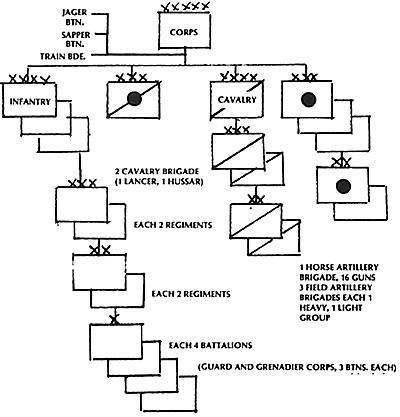
Grand Tactical Wargame for 1850-71
Back to Table of Contents -- Courier Vol. VII #5
To Courier List of Issues
To MagWeb Master Magazine List
© Copyright 1987 by The Courier Publishing Company.
This article appears in MagWeb (Magazine Web) on the Internet World Wide Web.
Other military history articles and gaming articles are available at http://www.magweb.com